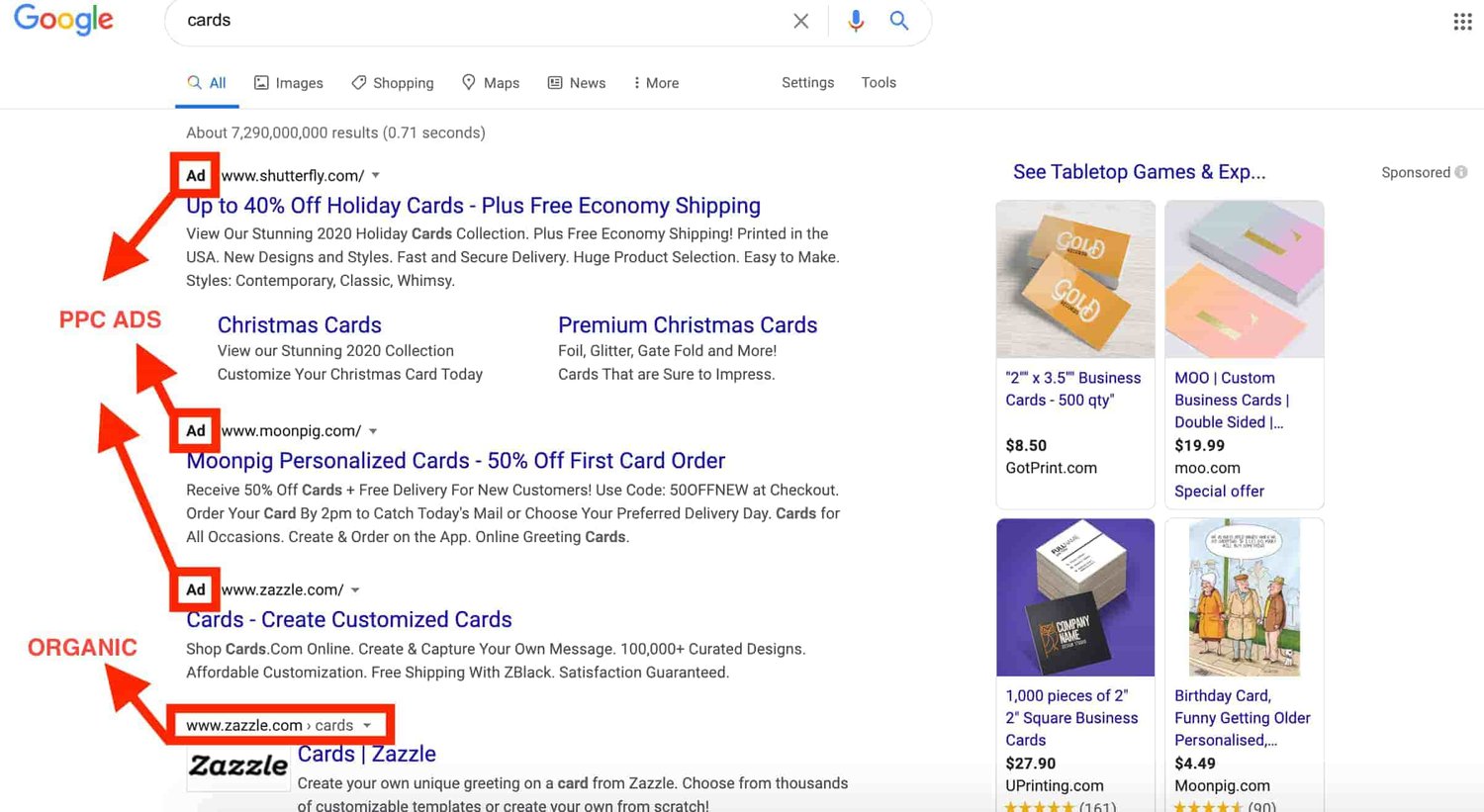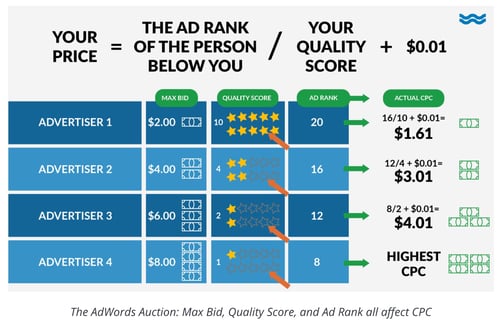How does PPC work?
Pay-per-click, PPC, is a paid advertising model that falls under search engine marketing (SEM). With PPC, the advertiser only pays when people interact with their ad through impressions or clicks.
When done right, PPC can earn you quality leads. If you can create a seamless user journey (which you’ll learn how to do later in this piece), it could mean a huge ROI for your PPC efforts.
Pay-per-click advertising is most common in search engine results pages (SERPs), like Google or Bing, but is also used on social channels (although CPM is more common). If you’re wondering where you can find pay-per-click ads, they’re the results you see before and to the right of the organic search results. For instance, check out the ad that came up in my search for "cards”.

Benefits of PPC
So, why would you pay for ads when you can reach your audience organically through great content and strategically-placed keywords (otherwise known as SEO)?
The answer is: keywords have become increasingly competitive. This makes it more difficult for a business that doesn’t have the domain authority to get them into the top rankings on a search engine or in front of their target audience on a social platform. In fact, so many businesses are using ads that organic results often don’t even start until you’re further down the page.
That doesn’t mean you should ditch all SEO efforts completely — your paid advertising should complement your SEO strategy as opposed to replace it.
“When people search for your keywords, you know their search intent and can display the most relevant ad to your audience. This means more clicks and a greater chance of conversion.” - Laura Mittelmann, Paid Acquisition at HubSpot
Paid advertising will help you rise to the top in a competitive market and be seen by potential customers who may not know that you exist. It can help you promote your next marketing initiative, improve brand awareness, or rank for difficult keyword terms. In other words, PPC is your shortcut to getting to the top within your niche. And, if done responsibly, PPC can be integral to your inbound marketing strategy.
PPC-Related Terms You Should Know
What’s a marketing channel without a few acronyms and a little jargon? If you’re going to enter the paid advertising space, there are a few terms you should know. Below, we review the main elements of a PPC campaign, ranging from broad to the more specific.
Search Engine Marketing (SEM)
The objective of all forms of digital advertising is to rank for a target keyword, and that can be done in a number of ways. Search Engine Marketing (SEM) refers to any digital marketing (paid or unpaid) done on a search engine, like Google, Yahoo, or Bing. SEM is an umbrella term that encompasses both paid advertising and search engine optimization, that is, ranking organically for keywords. It’s important to note that not all PPC occurs on search engines — social media has PPC ads, too (think: Facebook Ads).
CPC
Cost-per-click (CPC) is the amount that an advertiser pays for each click on your ad. CPC acts as your bid in an auction that determines where your ad will be placed. As you can imagine, a higher bid equates to better ad placement. You set your CPC at the maximum price you are willing to pay per click on your ad. What you actually pay is determined by the following formula: (Competitor’s Ad Rank / Your Quality Score) + 0.01 = Actual CPC. Let’s go over the terms in this equation so you know what you’re paying for:
Ad Rank
This value determines the position of an ad on a search engine results page. It’s equal to Maximum Bid x Quality Score.
Quality Score
This is the score that search engines give to your ad based on your clickthrough rate (CTR) — measured against the average CTR of ads in that position — the relevance of your keywords, the quality of your landing page, and your past performance on the SERP.
Maximum Bid
This is the maximum you're willing to pay per click on you ad.
Here’s an image by WordStream that illustrates what I mean:

Source
You can set your CPC to manual, where you determine the maximum bid for your ads, or enhanced, which allows the search engines to adjust your bid based on your goals. One of these enhanced options involves bid strategies that automatically adjust your bids based on either clicks or conversions.
PPC vs. CPC
PPC and CPC are not technically the same thing. PPC refers to a style of marketing that includes paying for advertisements. CPC, or cost-per-click, refers to the amount of money you spend on a single click on your ad.
CPM (Cost per Mille)
CPM, also known as cost per thousand, is the cost per one thousand impressions. It’s most commonly used for paid social and display ads. There are other types of cost-pers… like cost-per-engagement, cost-per-acquisition (CPA), but for the sake of preserving your mental space, we’re going to stick with clicks, a.k.a. CPC.
Campaign
The first step in setting up your PPC ads is determining your ad campaign. You can think of your campaign as the key message, or theme, you want to get across with your advertisements.
Ad Group
One size doesn’t fit all. That’s why you’ll create a series of ads within your campaign based on a set of highly related keywords. You can set a CPC for each ad group that you create.
Keywords
Each ad within your ad group will target a set of relevant keywords or key terms. These keywords tell search engines which terms or search queries you want your ad to be displayed alongside in SERPs. Once you determine which keywords perform best, you can set a micro CPC just for keywords within your ads.
Ad Text
Your keywords should inform your ad text. Remember, your Quality Score is determined by how relevant your ad is, therefore, the text in your ad (and landing page for that matter) should match the keyword terms that you’re targeting.
Landing Page
A landing page is a critical piece of your paid advertising strategy. The landing page is where users will end up once they click your PPC ad. Whether it’s a dedicated webpage, your homepage, or somewhere else, make sure to follow landing page best practices to maximize conversions.
Best PPC Platforms
Now that you understand the PPC basics, I’m guessing your next question is: Where should I advertise?
There are dozens of online spaces where you can spend your coveted ad money, and the best way to vet them is by taking a close look at your potential ROI on each platform.
The most popular advertising platforms are effective because they’re easy to use, and, most importantly, highly trafficked. But for a smaller budget, you might consider a lesser-known alternative to these key players. Some additional things to consider when choosing a platform are the availability of keyword terms, where your target audience spends their time, and your advertising budget.
Comments
Post a Comment